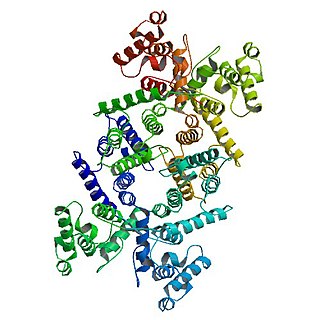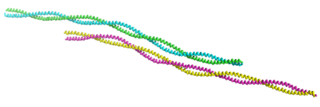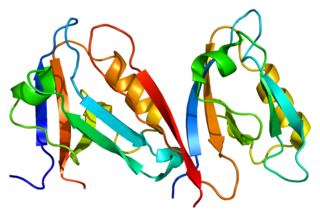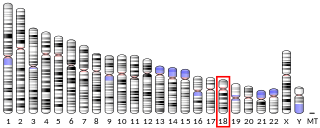Related Research Articles

Dystrophin is a rod-shaped cytoplasmic protein, and a vital part of a protein complex that connects the cytoskeleton of a muscle fiber to the surrounding extracellular matrix through the cell membrane. This complex is variously known as the costamere or the dystrophin-associated protein complex (DAPC). Many muscle proteins, such as α-dystrobrevin, syncoilin, synemin, sarcoglycan, dystroglycan, and sarcospan, colocalize with dystrophin at the costamere. It has a molecular weight of 427 kDa

Tropomyosin is a two-stranded alpha-helical, coiled coil protein found in many animal and fungal cells. In animals, it is an important component of the muscular system which works in conjunction with troponin to regulate muscle contraction. It is present in smooth and striated muscle tissues, which can be found in various organs and body systems, including the heart, blood vessels, respiratory system, and digestive system. In fungi, tropomyosin is found in cell walls and helps maintain the structural integrity of cells.
Derek Blake was, until 2007, the Isobel Laing Post-Doctoral Fellow in Biomedical Sciences, and the Wellcome Trust Senior Fellow in Basic Biomedical Science, Oriel College, Oxford.
The sarcoglycans are a family of transmembrane proteins involved in the protein complex responsible for connecting the muscle fibre cytoskeleton to the extracellular matrix, preventing damage to the muscle fibre sarcolemma through shearing forces.

Dystroglycan is a protein that in humans is encoded by the DAG1 gene.

Utrophin is a protein that in humans is encoded by the UTRN gene. The name is a short form for ubiquitous dystrophin.

Synemin, also known as desmuslin, is a protein that in humans is encoded by the SYNM gene. Synemin is an intermediate filament (IF) family member. IF proteins are cytoskeletal proteins that confer resistance to mechanical stress and are encoded by a dispersed multigene family. This protein has been found to form a linkage between desmin, which is a subunit of the IF network, and the extracellular matrix, and provides an important structural support in muscle.

Originally identified as Kirsten ras associated gene (KRAG), sarcospan (SSPN) is a 25-kDa transmembrane protein located in the dystrophin-associated protein complex of skeletal muscle cells, where it is most abundant. It contains four transmembrane spanning helices with both N- and C-terminal domains located intracellularly. Loss of SSPN expression occurs in patients with Duchenne muscular dystrophy. Dystrophin is required for proper localization of SSPN. SSPN is also an essential regulator of Akt signaling pathways. Without SSPN, Akt signaling pathways will be hindered and muscle regeneration will not occur.
The syntrophins are a family of five 60-kiloDalton proteins that are associated with dystrophin, the protein associated with Duchenne muscular dystrophy and Becker muscular dystrophy. The name comes from the Greek word syntrophos, meaning "companion." The five syntrophins are encoded by separate genes and are termed α, β1, β2, γ1, and γ2. Syntrophin was first identified as a dystrophin-associated protein present in the Torpedo electric organ. Subsequently, α-syntrophin was shown to be the predominant isoform in skeletal muscle where it is localized on the sarcolemma and enriched at the neuromuscular junction. The β-syntrophins and γ2-syntrophin are also present in skeletal muscle but also are in most other tissues. The expression of γ1-syntrophin is mostly confined to brain. The syntrophins are adaptor proteins that use their multiple protein interaction domains to localize a variety of signaling proteins to specific intracellular locations. α-Syntrophin binds to nNOS in the dystrophin-associated glycoprotein complex in skeletal muscle cells. There it produces NO upon muscle contraction leading to dilation of the arteries in the local area.

Alpha-1-syntrophin is a protein that in humans is encoded by the SNTA1 gene. Alpha-1 syntrophin is a signal transducing adaptor protein and serves as a scaffold for various signaling molecules. Alpha-1 syntrophin contains a PDZ domain, two Pleckstrin homology domain and a 'syntrophin unique' domain.

β-Tropomyosin, also known as tropomyosin beta chain is a protein that in humans is encoded by the TPM2 gene. β-tropomyosin is striated muscle-specific coiled coil dimer that functions to stabilize actin filaments and regulate muscle contraction.

Beta-sarcoglycan is a protein that in humans is encoded by the SGCB gene.

Delta-sarcoglycan is a protein that in humans is encoded by the SGCD gene.

Beta-2-syntrophin is a protein that in humans is encoded by the SNTB2 gene.

Alpha-sarcoglycan is a protein that in humans is encoded by the SGCA gene.

Gamma-sarcoglycan is a protein that in humans is encoded by the SGCG gene. The α to δ-sarcoglycans are expressed predominantly (β) or exclusively in striated muscle. A mutation in any of the sarcoglycan genes may lead to a secondary deficiency of the other sarcoglycan proteins, presumably due to destabilisation of the sarcoglycan complex. The disease-causing mutations in the α to δ genes cause disruptions within the dystrophin-associated protein (DAP) complex in the muscle cell membrane. The transmembrane components of the DAP complex link the cytoskeleton to the extracellular matrix in adult muscle fibres, and are essential for the preservation of the integrity of the muscle cell membrane.

Beta-1-syntrophin is a protein that in humans is encoded by the SNTB1 gene.

Dystrobrevin alpha is a protein that in humans is encoded by the DTNA gene.

Dystrobrevin beta is a protein which in humans is encoded by the DTNB gene.
References
- 1 2 Yeadon JE, Lin H, Dyer SM, Burden SJ (November 1991). "Dystrophin is a component of the subsynaptic membrane". The Journal of Cell Biology. 115 (4): 1069–76. doi:10.1083/jcb.115.4.1069. PMC 2289946 . PMID 1720119.
- ↑ Carr C, Fischbach GD, Cohen JB (October 1989). "A novel 87,000-Mr protein associated with acetylcholine receptors in Torpedo electric organ and vertebrate skeletal muscle". The Journal of Cell Biology. 109 (4 Pt 1): 1753–64. doi:10.1083/jcb.109.4.1753. PMC 2115790 . PMID 2793938.
- ↑ Butler MH, Douville K, Murnane AA, Kramarcy NR, Cohen JB, Sealock R, Froehner SC (March 1992). "Association of the Mr 58,000 postsynaptic protein of electric tissue with Torpedo dystrophin and the Mr 87,000 postsynaptic protein". The Journal of Biological Chemistry. 267 (9): 6213–8. doi: 10.1016/S0021-9258(18)42683-X . PMID 1556129.
- 1 2 3 Sadoulet-Puccio HM, Rajala M, Kunkel LM (November 1997). "Dystrobrevin and dystrophin: an interaction through coiled-coil motifs". Proceedings of the National Academy of Sciences of the United States of America. 94 (23): 12413–8. Bibcode:1997PNAS...9412413S. doi: 10.1073/pnas.94.23.12413 . PMC 24974 . PMID 9356463.
- ↑ Roberts RG (2001). "Dystrophins and dystrobrevins". Genome Biology. 2 (4): REVIEWS3006. doi: 10.1186/gb-2001-2-4-reviews3006 . PMC 138928 . PMID 11305946.
- 1 2 Constantin B (February 2014). "Dystrophin complex functions as a scaffold for signalling proteins". Biochimica et Biophysica Acta (BBA) - Biomembranes. 1838 (2): 635–42. doi: 10.1016/j.bbamem.2013.08.023 . PMID 24021238.
- 1 2 Blake DJ, Nawrotzki R, Loh NY, Górecki DC, Davies KE (January 1998). "beta-dystrobrevin, a member of the dystrophin-related protein family". Proceedings of the National Academy of Sciences of the United States of America. 95 (1): 241–6. Bibcode:1998PNAS...95..241B. doi: 10.1073/pnas.95.1.241 . PMC 18188 . PMID 9419360.
- ↑ Roberts RG, Bobrow M (April 1998). "Dystrophins in vertebrates and invertebrates". Human Molecular Genetics. 7 (4): 589–95. doi: 10.1093/hmg/7.4.589 . PMID 9499411.
- ↑ Holland PW, Garcia-Fernàndez J, Williams NA, Sidow A (1994). "Gene duplications and the origins of vertebrate development". Development. 1994: 125–33. doi:10.1242/dev.1994.Supplement.125. PMID 7579513.
- 1 2 3 Blake DJ, Tinsley JM, Davies KE, Knight AE, Winder SJ, Kendrick-Jones J (April 1995). "Coiled-coil regions in the carboxy-terminal domains of dystrophin and related proteins: potentials for protein-protein interactions". Trends in Biochemical Sciences. 20 (4): 133–5. doi:10.1016/s0968-0004(00)88986-0. PMID 7770909.
- 1 2 3 Sadoulet-Puccio HM, Feener CA, Schaid DJ, Thibodeau SN, Michels VV, Kunkel LM (May 1997). "The genomic organization of human dystrobrevin". Neurogenetics. 1 (1): 37–42. doi:10.1007/s100480050006. PMID 10735273. S2CID 22588879.
- 1 2 3 Blake DJ, Nawrotzki R, Peters MF, Froehner SC, Davies KE (March 1996). "Isoform diversity of dystrobrevin, the murine 87-kDa postsynaptic protein". The Journal of Biological Chemistry. 271 (13): 7802–10. doi: 10.1074/jbc.271.13.7802 . PMID 8631824.
- ↑ Nawrotzki R, Loh NY, Ruegg MA, Davies KE, Blake DJ (September 1998). "Characterisation of alpha-dystrobrevin in muscle". Journal of Cell Science. 111 ( Pt 17) (17): 2595–605. doi:10.1242/jcs.111.17.2595. PMID 9701558.
- ↑ Enigk RE, Maimone MM (October 1999). "Differential expression and developmental regulation of a novel alpha-dystrobrevin isoform in muscle". Gene. 238 (2): 479–88. doi:10.1016/S0378-1119(99)00358-3. PMID 10570976.
- ↑ Yoshida M, Hama H, Ishikawa-Sakurai M, Imamura M, Mizuno Y, Araishi K, et al. (April 2000). "Biochemical evidence for association of dystrobrevin with the sarcoglycan-sarcospan complex as a basis for understanding sarcoglycanopathy". Human Molecular Genetics. 9 (7): 1033–40. doi: 10.1093/hmg/9.7.1033 . PMID 10767327.
- ↑ Peters MF, Sadoulet-Puccio HM, Grady MR, Kramarcy NR, Kunkel LM, Sanes JR, et al. (September 1998). "Differential membrane localization and intermolecular associations of alpha-dystrobrevin isoforms in skeletal muscle". The Journal of Cell Biology. 142 (5): 1269–78. doi:10.1083/jcb.142.5.1269. PMC 2149339 . PMID 9732287.
- 1 2 Blake DJ, Nawrotzki R, Loh NY, Górecki DC, Davies KE (January 1998). "beta-dystrobrevin, a member of the dystrophin-related protein family". Proceedings of the National Academy of Sciences of the United States of America. 95 (1): 241–6. Bibcode:1998PNAS...95..241B. doi: 10.1073/pnas.95.1.241 . PMC 18188 . PMID 9419360.
- 1 2 Böhm SV, Roberts RG (2009). "Expression of members of the dystrophin, dystrobrevin, and dystrotelin superfamily". Critical Reviews in Eukaryotic Gene Expression. 19 (2): 89–108. doi:10.1615/critreveukargeneexpr.v19.i2.10. PMID 19392646.
- ↑ Ahn AH, Freener CA, Gussoni E, Yoshida M, Ozawa E, Kunkel LM (February 1996). "The three human syntrophin genes are expressed in diverse tissues, have distinct chromosomal locations, and each bind to dystrophin and its relatives". The Journal of Biological Chemistry. 271 (5): 2724–30. doi: 10.1074/jbc.271.5.2724 . PMID 8576247.
- ↑ Ahn AH, Kunkel LM (February 1995). "Syntrophin binds to an alternatively spliced exon of dystrophin". The Journal of Cell Biology. 128 (3): 363–71. doi:10.1083/jcb.128.3.363. PMC 2120343 . PMID 7844150.
- ↑ "About Duchenne Muscular Dystrophy". Genome.gov. Retrieved 2020-04-30.
- 1 2 Strakova J, Dean JD, Sharpe KM, Meyers TA, Odom GL, Townsend D (November 2014). "Dystrobrevin increases dystrophin's binding to the dystrophin-glycoprotein complex and provides protection during cardiac stress". Journal of Molecular and Cellular Cardiology. 76: 106–15. doi:10.1016/j.yjmcc.2014.08.013. PMC 4271192 . PMID 25158611.